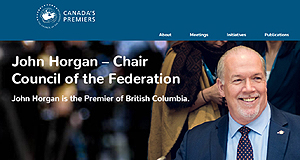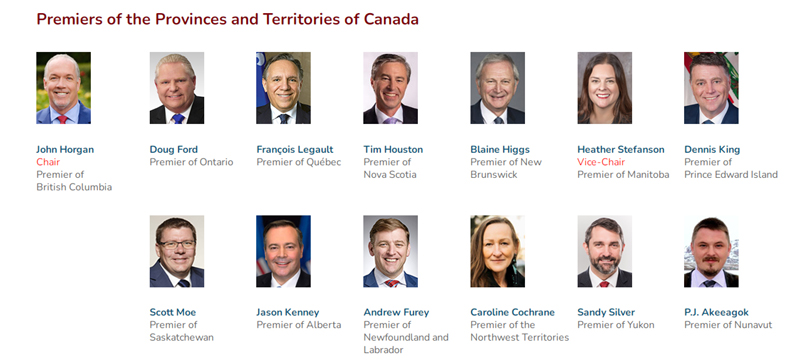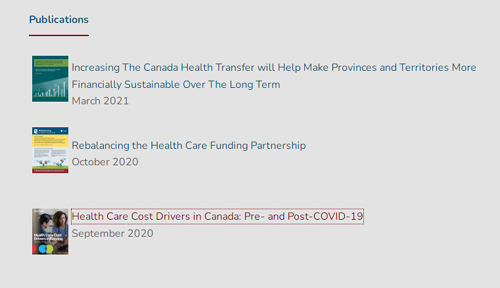
Sunday December 12, 2021 | VICTORIA, BC
News analysis by Mary P Brooke, B.Sc. | Island Social Trends
Canada’s Premiers met on Thursday December 9 by teleconference to discuss the pandemic and the urgent need to resolve the structural funding shortfall facing our health care systems.
Not much detail was released. But there was a going-forward statement:
“We need a renewed and reinvigorated partnership for health care funding in Canada, and this requires First Ministers to come together in person and have a meaningful discussion,” said British Columbia Premier John Horgan, Chair, Council of the Federation (COF), as stated in a news release from his premier’s office.
The topic for discussion is the Canada Health Transfer (CHT).
Pushing forward on the CHT file:
Despite Horgan’s own current personal health challenges, he is steadfast on pursuing what he sees as a necessary boost to the amount of money that the federal government contributes to the provinces for health-care.
Health-care delivery is a provincial responsibility. And while health-care costs in general have been rising in recent years due to inflation, population growth, and an aging population, the impact of the COVID-19 pandemic has riveted attention on the urgent need to deal with establishing a sustainable health-care funding model across Canada.

Horgan was impacted early on in his career by meeting Tommy Douglas who (as then premier of Saskatchewan) spearheaded the original health-care funding system in Canada. Now Horgan (who has been premier of BC since 2017) has an opportunity to lead the rest of Canada’ premiers in the fight for sustaining the universal health-care system in this country.
Due to the impact of COVID, no doubt the agreement among premiers was relatively easy to attain, regardless of political stripe.
Challenges to the system:
“Premiers understand the challenges facing our health care systems and recognize a new vision for health care, supported by a significant, long-term increase in federal funding, is needed to ensure we emerge stronger from the COVID-19 pandemic,” it was stated in Thursday’s release.
“All Premiers agree on the urgent need for the federal government to increase its share of provincial-territorial health care costs through the Canada Health Transfer to 35%, which represents an immediate injection of $28 billion,” it was stated in the December 9 release.
Back in February 2021, a document called Increasing The Canada Health Transfer will Help Make Provinces and Territories More Financially Sustainable Over the Long Term said the same thing.
Firm at 35%:
There is not yet any indication as to how the negotiations between premiers and the prime minister will go. Will the provinces and territories set a firm request of increasing the federal share to 35% right away, or agree to seeing it phased in over a number of years?
Prime Minister Justin Trudeau has indicated in the past year that he is willing to revisit a discussion about the Canada Health Transfer (CHT), but said that should happen after COVID is over. However, it appears that COVID is not going to be over any time soon, according to all health and science sources.
The February 2021 document (the latest in a series of three document released by the Council of the Federation in 2020 and 2021) shows a proposed increase of $27.6 billion as being required in 2021-2022; that would increase the transfer amount from $41.9 billion in 2020-2021 to $69.5 billion for 2021-2022. However, at this point, that’s rather moot (the fiscal year runs from April 1 each year), unless a transfer is applied retroactively.
Indeed, the 35% goal in one intact increase appears to the goal of the premiers:
“An annual escalator of 5% thereafter would maintain the CHT level at 35% of provincial and territorial health expenditures,” it was stated by COF in February 2021.
“A high annual escalator would be necessary to reach an amount equivalent to 35% of aggregate provincial and territorial health expenditures if the CHT was not immediately increased to that level in 2021-2022, in order to ensure a catch-up,” it was stated back in February of this year.
COVID-related cost increases:
In a COF document called Health Care Cost Drivers in Canada – Pre-and-Post-COVID-19 (published in September 2020 by the Conference Board of Canada), the annual cost increases to provinces, due to COVID alone, included a wide range of factors: testing, treatment and recovery, PPE, medical supplies, pharmaceuticals and other supplies and services on addressing health effects of the pandemic.

The costs to manage COVID were pegged at between 6.5% and 8.4% (projected for the years 2019-2020 and 2022-2023).
COVID vaccines were made available in Canada at the end of 2020. So of course, now the cost of immunization rollouts can be added to the list of costs borne by the provinces and territories; the cost of vaccine procurement and supply has, until now, been undertaken by the federal government.
Otherwise, the annual cost increases (before COVID came into the picture) had already been projected at 5.4% per year (due to inflation, population growth, and population aging), for the period out to and including 2030-31.
Provinces & territories need the cash:
All premiers agree on the need to focus on outcomes, specificially “to be accountable to our own residents for the responsible investment of their tax dollars, and to meet the urgent demands for improved health services across the country,” it was stated after the December 9 meeting.
The more that provinces and territories underwrite the costs of an ever-increasing health delivery bill, less funding is available for all the other services and programs delivered by governments. Other large budget expenditures for provinces include education and the overall cost of running government (salaries, offices, infrastructure, administration), and in BC lately the increased cost of emergency management (wildfires, heat, floods).
Urgency:
Premiers have invited the Prime Minister to work with them and begin negotiations without further delay so that a First Ministers’ Agreement on Sustainable Health Care Funding can be finalized early in the New Year, ahead of federal, provincial and territorial budgets. Most budgets are delivered in February or March, for the upcoming fiscal year starting April 1.
“Over the past 20 months, Canada’s First Ministers have demonstrated that when we work together, we can deliver results for Canadians. Premiers look forward to applying this same approach to ensure that Canada’s public health care systems remain sustainable for generations to come,” it was stated in the December 9 COF release, issued from Premier Horgan’s office.
COF:
The Council of the Federation (COF) comprises all 13 provincial and territorial Premiers. The website is called “Canada’s Premiers”. COF says their collaboration “enables Premiers to work collaboratively, form closer ties, foster constructive relationships among governments, and show leadership on important issues that matter to Canadians”.

===== BACKGROUND:
Canadian Museum of History – about Tommy Douglas
===== RELATED:
BC Premier Horgan back after surgery & working remotely (Nov 4, 2021)
Horgan promptly into hospital raises ire among the underserved (Nov 2, 2021)
BC Premier Horgan having surgery, appoints Mike Farnworth as deputy premier (Oct 28, 2021)
Premiers pushing for Canada Health Transfer increase, says Horgan (Sept 23, 2021)





